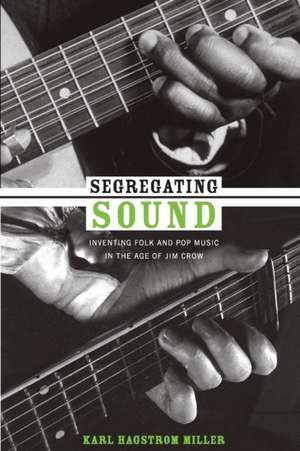Segregating Sound – Inventing Folk and Pop Music in the Age of Jim Crow: Refiguring American Music
Autor Karl Hagstrom Milleren Limba Engleză Paperback – 10 feb 2010
Din seria Refiguring American Music
-
 Preț: 159.67 lei
Preț: 159.67 lei -
 Preț: 193.37 lei
Preț: 193.37 lei -
 Preț: 241.55 lei
Preț: 241.55 lei -
 Preț: 173.87 lei
Preț: 173.87 lei -
 Preț: 179.67 lei
Preț: 179.67 lei -
 Preț: 149.76 lei
Preț: 149.76 lei -
 Preț: 176.27 lei
Preț: 176.27 lei -
 Preț: 175.26 lei
Preț: 175.26 lei -
 Preț: 157.59 lei
Preț: 157.59 lei -
 Preț: 168.76 lei
Preț: 168.76 lei -
 Preț: 166.35 lei
Preț: 166.35 lei -
 Preț: 160.40 lei
Preț: 160.40 lei -
 Preț: 130.46 lei
Preț: 130.46 lei -
 Preț: 231.12 lei
Preț: 231.12 lei -
 Preț: 262.32 lei
Preț: 262.32 lei -
 Preț: 263.47 lei
Preț: 263.47 lei -
 Preț: 258.50 lei
Preț: 258.50 lei -
 Preț: 262.32 lei
Preț: 262.32 lei -
 Preț: 306.77 lei
Preț: 306.77 lei -
 Preț: 264.82 lei
Preț: 264.82 lei -
 Preț: 195.18 lei
Preț: 195.18 lei -
 Preț: 305.46 lei
Preț: 305.46 lei -
 Preț: 305.08 lei
Preț: 305.08 lei -
 Preț: 302.19 lei
Preț: 302.19 lei -
 Preț: 298.50 lei
Preț: 298.50 lei - 23%
 Preț: 775.73 lei
Preț: 775.73 lei -
 Preț: 304.31 lei
Preț: 304.31 lei -
 Preț: 237.63 lei
Preț: 237.63 lei -
 Preț: 264.82 lei
Preț: 264.82 lei -
 Preț: 245.82 lei
Preț: 245.82 lei -
 Preț: 268.09 lei
Preț: 268.09 lei -
 Preț: 261.38 lei
Preț: 261.38 lei
Preț: 238.51 lei
Nou
Puncte Express: 358
Preț estimativ în valută:
45.65€ • 49.61$ • 38.37£
45.65€ • 49.61$ • 38.37£
Carte tipărită la comandă
Livrare economică 21 aprilie-05 mai
Preluare comenzi: 021 569.72.76
Specificații
ISBN-13: 9780822347002
ISBN-10: 0822347008
Pagini: 384
Dimensiuni: 159 x 239 x 28 mm
Greutate: 0.51 kg
Ediția:New.
Editura: MD – Duke University Press
Seria Refiguring American Music
ISBN-10: 0822347008
Pagini: 384
Dimensiuni: 159 x 239 x 28 mm
Greutate: 0.51 kg
Ediția:New.
Editura: MD – Duke University Press
Seria Refiguring American Music
Recenzii
In this head-banging, eye-opening study, Karl Hagstrom Miller examines with stunning clarity the historical and material grounding of the music industrys three main revenue streams: live performance, recording, and publishing. Along the way, he demonstrates how the notion of authenticity in folklore discourse, systemic Jim Crow, and minstrelsy legacies worked together to calcify our contemporaryand quite naturalizedperceptions about music and racialized bodies. If you ever wondered where MTV, CMT, VH1, and BET got their marketing logic, look no further. In fact, youll never experience a Billboard chart, nor the words keep it real in the same way after reading this book!Guthrie P. Ramsey Jr., author of Race Music: Black Cultures from Bebop to Hip-Hop
"In this head-banging, eye-opening study, Karl Hagstrom Miller examines with stunning clarity the historical and material grounding of the music industry's three main revenue streams: live performance, recording, and publishing. Along the way, he demonstrates how the notion of authenticity in folklore discourse, systemic Jim Crow, and minstrelsy legacies worked together to calcify our contemporary--and quite naturalized--perceptions about music and racialized bodies. If you ever wondered where MTV, CMT, VH1, and BET got their marketing logic, look no further. In fact, you'll never experience a Billboard chart, nor the words 'keep it real' in the same way after reading this book!"--Guthrie P. Ramsey Jr., author of Race Music: Black Cultures from Bebop to Hip-Hop
"In this head-banging, eye-opening study, Karl Hagstrom Miller examines with stunning clarity the historical and material grounding of the music industry's three main revenue streams: live performance, recording, and publishing. Along the way, he demonstrates how the notion of authenticity in folklore discourse, systemic Jim Crow, and minstrelsy legacies worked together to calcify our contemporary--and quite naturalized--perceptions about music and racialized bodies. If you ever wondered where MTV, CMT, VH1, and BET got their marketing logic, look no further. In fact, you'll never experience a Billboard chart, nor the words 'keep it real' in the same way after reading this book!"--Guthrie P. Ramsey Jr., author of Race Music: Black Cultures from Bebop to Hip-Hop
Notă biografică
Karl Hagstrom Miller
Textul de pe ultima copertă
"In this head-banging, eye-opening study, Karl Hagstrom Miller examines with stunning clarity the historical and material grounding of the music industry's three main revenue streams: live performance, recording, and publishing. Along the way, he demonstrates how the notion of authenticity in folklore discourse, systemic Jim Crow, and minstrelsy legacies worked together to calcify our contemporary--and quite naturalized--perceptions about music and racialized bodies.If you ever wondered where MTV, CMT, VH1, and BET got their marketing logic, look no further. In fact, you'll never experience a "Billboard" chart, nor the words 'keep it real' in the same way after reading this book!"--Guthrie P. Ramsey Jr., author of "Race Music: Black Cultures from Bebop to Hip-Hop"
Cuprins
Acknowledgments vii
Introduction 1
1. Tin Pan Alley on Tour: The Southern Embrace of Commercial Music 23
2. Making Money Making Music: The Education of Southern Musicians in Local Markets 51
3. Isolating Folk, Isolating Songs: Reimagining Southern Music as Folklore 85
4. Southern Musicians and the Lure of New York City: Representing the South from Coon Songs to the Blues 121
5. Talking Machine World: Discovering Local Music in the Global Phonograph Industry 157
6. Race Records and Old-Time Music: The Creation of Two Marketing Categories in the 1920s 187
7. Black Folk and Hillbilly Pop: Industry Enforcement of the Musical Color Line 215
8. Reimagining Pop Tunes as Folk Songs: The Ascension of the Folkloric Paradigm 241
Afterword: "All Songs is Folk Songs" 275
Notes 283
Bibliography 327
Index 351
Introduction 1
1. Tin Pan Alley on Tour: The Southern Embrace of Commercial Music 23
2. Making Money Making Music: The Education of Southern Musicians in Local Markets 51
3. Isolating Folk, Isolating Songs: Reimagining Southern Music as Folklore 85
4. Southern Musicians and the Lure of New York City: Representing the South from Coon Songs to the Blues 121
5. Talking Machine World: Discovering Local Music in the Global Phonograph Industry 157
6. Race Records and Old-Time Music: The Creation of Two Marketing Categories in the 1920s 187
7. Black Folk and Hillbilly Pop: Industry Enforcement of the Musical Color Line 215
8. Reimagining Pop Tunes as Folk Songs: The Ascension of the Folkloric Paradigm 241
Afterword: "All Songs is Folk Songs" 275
Notes 283
Bibliography 327
Index 351
Descriere
Asks how the racialized genre divisions in American commerical music came into being, and how they became so entrenched, challenging the assumption of strict musical segregation in the late-19th-century rural South.















